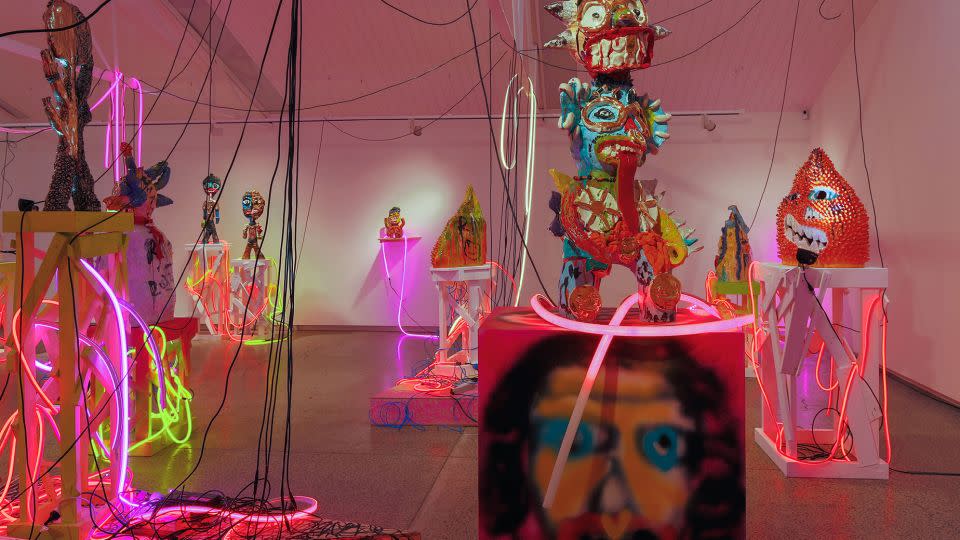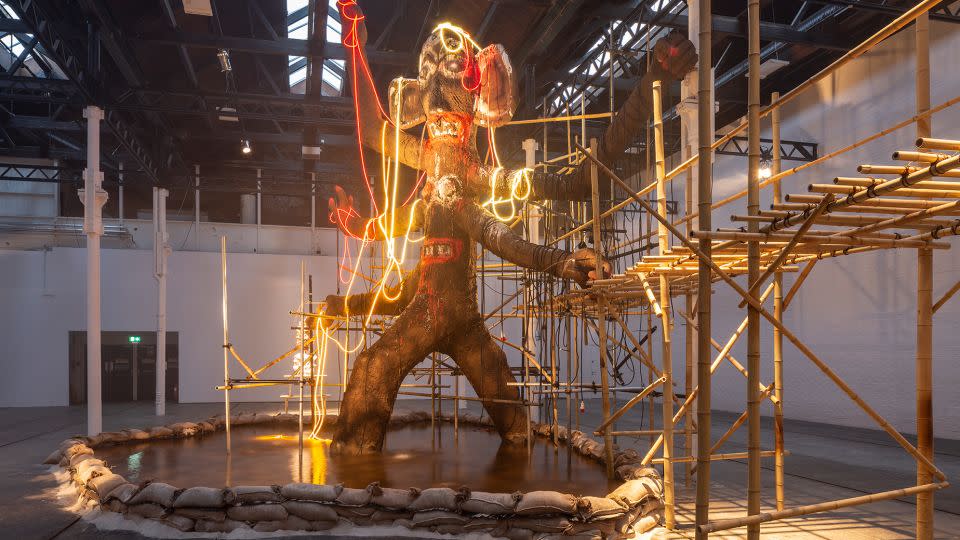Smoke machines, idols and a makeshift temple: Meet Ramesh Mario Nithiyendran, the ‘bad boy of ceramics’
Ramesh Mario Nithiyendran is striking a pose. He’s pouting, slightly; scowling, gently; and dressed in an acid-bright floral shirt with pink trousers and lilac flatform Crocs. It’s a characteristically flamboyant ensemble for the 35-year-old Sri Lanka-born, Sydney-based artist, who is being photographed at Scottish arts venue Tramway, in Glasgow, to celebrate his equally flamboyant new exhibition.
In the cavernous former tram depot, Nithiyendran has brought together a collection of his increasingly sought-after sculptures — ceramic and brass mashups of ancient deities, pop-culture references and queer sensibilities — in dramatic fashion. The exhibition is both visual spectacle and sensory experience, featuring a makeshift “temple” structure and a towering mud-and-straw sculpture, which is strung with neon LED lighting and doubles as a fountain dripping into a pool of murky water. It’s an exuberant exploration of global mythologies and cultural identities, with added theatricality courtesy of a smoke machine.
“I’ve never wanted to make art that speaks only to an art-literate audience,” said Nithiyendran, sitting cross-legged, Crocs kicked off, on a sofa in the Tramway cafe, his long curly hair coiled up in a top knot. “Like, I’m not interested in hardcore abstraction or really conceptual art. I’m not interested in photorealistic painting. I like complex ideas, but a lot of art can be self-referential, and I just think that is so boring.”

What he is interested in, though, is “engaging different audiences” and “referencing non-Western narratives, especially those of South Asia.” Born in Colombo, Sri Lanka, Nithiyendran immigrated to Australia with his parents at the age of 1, and his own Tamil heritage is woven into his idol-inspired yet playful, part-animal, part-human forms.
A bronze sculpture prominently positioned in the Tramway space, for instance, is described by Nithiyendran as a “kind of guardian, warrior, destroyer, protector all at once.” It both references ancient Buddhist and Hindu imagery of seated figures and conglomerates contemporary references. “That’s a banana; that’s Hello Kitty; these are dragon masks from a Halloween shop,” said Nithiyendran, pointing to the different elements he cast using the traditional lost-wax technique before welding them together to combine the divine with the “detritus of everyday life”, and the momentous with “banality and humor.”
A star in his ascendency
In his native Australia, Nithiyendran is something of a household name as one of the youngest artists to stage a solo exhibition at the National Gallery of Australia. His work has been commissioned by both the Art Gallery of New South Wales and Queensland’s HOTA (Home of the Arts) museum, — where his imposing, 6-meter-tall (20-foot) public sculpture “Double-faced avatar with blue figure” greets visitors at the entrance.
“Idols of Mud and Water” is his first institutional solo exhibition in Europe, but his star is ascending globally. He is represented by Sullivan+Strumpf, which has galleries in Sydney, Melbourne and Singapore, as well as by Jhaveri Contemporary in Mumbai, India. “Ramesh’s fabulous polychrome hybrid figures were a real discovery for me at the 2018 Dhaka Art Summit in Bangladesh,” said Amrita Jhaveri, who runs the latter gallery with her sister, Priya. When they exhibited 14 of Nithiyendran’s bold and brashly colorful ceramic sculptures in Mumbai in 2022, the show “could have sold many times over”, wrote Priya over email, noting interest from collectors not only in Australia, but also Europe and China.

For Amrita, a major pull is Nithiyendran himself: “He’s such a colorful, engaging person with the most infectious laugh.” Tramway’s senior curator Claire Jackson agreed: “I just want to bask in his aura because he’s so charismatic and fun.”
And Nithiyendran is happy for his persona to be seen as part of his artistic practice. “If your work is bold, your person can also be bold and be read in relation to that work,” he said. “I think it’s important for artists to think about their presentation — it’s another type of art-making.”
When GQ Australia magazine named Nithiyendran “Artist of the Year” in 2022 an accompanying profile feature saw him posing next to his kiln in a high-fashion ensemble of a shearling poncho and monogrammed parachute pants, as well as heat-resistant safety gloves and his signature Crocs. The same year, Thames & Hudson published a monograph of his work titled, with pop-star-style panache, “Ramesh.” And his more recent November cover shoot for international contemporary art magazine ArtReview is no-less diva-ish, showing Nithiyendran in a pink puffer jacket unzipped to almost his midriff, bare chest out for all the art world to see.
“Quite early on (in my career), I noticed that people wanted to photograph me,” he said, his shirt substantially unbuttoned, even on a Scottish winter’s day. “I’m like, ‘Yes, I’m going to wear this. I’m going to pose this way. I’m looking at the camera.’ Growing up in Australia, artists from a similar cultural background (to me), or with darker skin, were never represented in my art history classes, so I thought to myself, ‘I’m going to lean into all the media (opportunities)’ because visibility is really important. Visibility can make a real impact.”
Making room for other voices
Nithiyendran’s new show is high on impact, but also aims to be “subversive within the spectacle framework,” the artist said. “I was really thinking conceptually and globally and philosophically about water and earth moving,” he said of the overarching theme. “Most cultures have some kind of flood myth that permeates through a lot of creation narratives.”

His “temple,” meanwhile, is a ramshackle hut cobbled together from salvaged wood, bamboo and tarpaulin sheets in reference to flood-responsive architecture. Inside, it houses a precariously arranged pyramid of 96 terracotta figures, glazed with gold, ranging from “amorphous mask-like forms” to more complex creations with “arms, legs, multiple heads and zoomorphic features.” Phallic protrusions also abound — an aspect of his work that has previously earned him the hard-to-shake label as “the bad boy of ceramics.”
“But I don’t see the sculptures as rule-breaking,” said Nithiyendran, who majored in women’s and gender studies at college before turning to art. The ceramic figures in the Tramway show all colorfully portray gender fluidity. “I call this one my queen,” said Nithiyendran pointing to one of three sculptures striking a more classical tone, inspired by Gandharan Buddhism, and incorporating multiple layers of glaze. “It references different kinds of fertility figures, but with a more of a queer sensibility.”
Nithiyendran also doesn’t see his work as “countering a Eurocentric patriarchal model,” but is instead interested in “making room for other kinds of voices” and “creating spaces that are uniquely parallel to each other.” And his vision is all-encompassing. “Stepping into the gallery space, you’re very much in Ramesh’s world,” said Jackson, adding that the installation process was soundtracked to “a lot of ‘90s girl groups,” and predicting that the opening night celebrations would culminate in a karaoke session.
“It’s diva themed,” said Nithiyendran with a warm and welcoming laugh, clearly enjoying the limelight of his growing success. “I’m from a refugee background. I grew up next to McDonald’s in a migrant suburb in Australia. So I’m proud of what I’ve achieved. I’m happy to own it.”
“Idols of Mud and Water” is showing at Tramway in Glasgow, UK until Apr. 21, 2024.
For more CNN news and newsletters create an account at CNN.com

